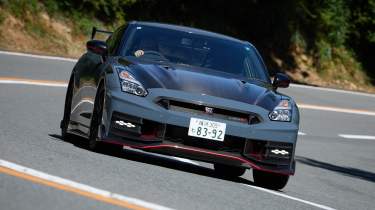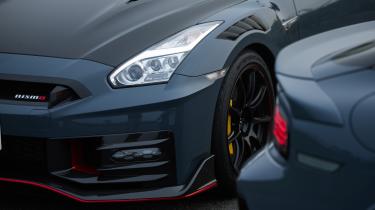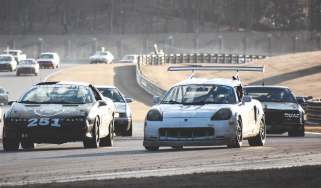2025 Nissan GT‑R Nismo Final Edition - Japan's 911 GT3 RS still has it
It's the last ever Nissan R35 GT-R (for now!), so where better to take it for a final drive than Japan's Hakone Turnpike
Is this the perfect place to say sayonara? Legend suggests so. The Hakone Turnpike has been immortalised in Japanese car culture, most notably by the manga of Initial D, cartoonish tyre smoke an’ all. As a place to let loose the final Nissan GT‑R Nismo, it ought to be perfect.
The R35 has already enjoyed a few goodbye pieces by our hands, one of them typed by my own almost three years ago following a few days on the roads of north Wales in a 2020MY Nismo (evo 298).
Thing is, production didn’t stop when ever-stricter regulations stymied GT‑R sales in Europe. Its notoriously fastidious engineering team didn’t down tools just because western Nissan dealers were starting to pack down the sexiest corner of their showroom to make room for more EVs. Sales remained possible in the car’s native Japan, so evolution of the boldest, brashest and arguably most brilliant JDM creation of them all continued apace.
This car is several steps on from that 2020 version. Here its powers are further honed and its body even more sculpted, even if its 3.8-litre twin-turbo V6 is no feistier, still with 592bhp and 481lb ft. The headlines are instead handed to a limited-slip differential on the front axle (a first for the GT‑R) and a rear wing that’s ten per cent larger and supported by seductive swan-neck struts.
More reviews
In-depth reviews
Reviews
- Nissan GT-R Nismo (R35, 2014 - 2025) review – Godzilla on steroids is a Japanese icon
- Nissan Skyline GT-R Hakosuka (1971): origin of the species
- 2017 Nissan GT-R review
- Nissan Skyline GT-R R32 - review, history, prices and specs
- Nissan GT-R review - The GT-R has never been more usable, yet it's still blisteringly fast
It sits above a new rear bumper whose diffuser incorporates upright carbon strakes and a very motorsport fog-light design. Special Edition trim is a nerdy options box tick bringing weight-balanced piston rings, connecting rods and crankshaft for extra trackday toughness.
The additional red detailing and clear-coat finish for the stock carbon bonnet (saving 100 grams!) are likely aimed at passers-by; the driver will be much more taken by the slimline carbon Recaros that are standard to all ’25 Nismos. I’m not sure I’ve seen a more alluring performance seat design, yet they support and cosset on the two-hour schlep to Hakone more than you’d dare believe and even carve out a mite more legroom in the weeny rear quarters.
The GT‑R beneath is its same old belligerent self on the trip, which I honestly mean as praise. Those clunks, groans and whirrs at low speed as its mechanicals and Nismo-only Dunlop SportMaxx tyres attempt to convert minor throttle and steering inputs into motion are as beguiling as ever.
They prove that Nissan’s dedication to kaizen – the philosophy of continued improvement – is flexible enough to allow deep-rooted character to course through the car. The three-stage Bilstein damping remains tough in each of its settings, though it’s amiable enough in Comfort for the miles to pass easily as the skyscrapers of Tokyo drop away to be replaced by the increasing altitude of the Kanagawa hills.
Even the lightest awareness of Japanese car culture will have your arm hairs on high command and a fizzy knot growing in your stomach as you roll up to the toll booth at the bottom of Hakone’s 1011m hill climb. Once I’ve handed over a thousand or so yen (call it a fiver) and passed through, my excitement dims at the sight of 50kph (31mph) limit signs. There’s little chance my heavily body-kitted, dying-of-the-light Nismo is slipping under anyone’s radar amid the quiet zen of a sunny Monday morning.
We retreat into a layby and soon find that the locals heading here in their heavily modified Silvias, ’86s and Mazda MX‑5s pay loose attention to the limit. As do the numerous highway maintenance staff working up and down the Turnpike, visually justifying the toll price before backing politely away once they hear the high revs and dispersed air of an approaching car. More chance to tap into the latest Nismo’s dynamics than I’d first imagined, then. Phew.
A grimy Welsh B-road feels a different universe to the warm, dry tarmac of Hakone’s surprisingly wide, high-speed turns. Far from being hairpin upon hairpin – like the legend might imply – most corners call for third or fourth gear from the familiar six-speed dual-clutch ’box.
I’ve always had to think hard before unleashing a Nissan GT‑R’s power like I can today: the bumps of a British road are among the quickest ways to destroy the myth that GT‑Rs drive themselves, yet the car feels almost foolproof on the Turnpike’s smooth surface, its Dunlops getting more vocal as I push harder, with no noticeable loss of traction.
We reach the top and bask in the majesty of Mount Fuji, the infamously shy mountain briefly peeking out between the clouds and filling the horizon from 40 miles away. But we don’t hang around too long. Like a number of great destination roads the world over, the best drives – and tests – lie away from the famous stretch.
Whether you turn left or right at the peak, the roads get narrower and bumpier, and string together one second-gear corner after another. Here the Nismo belies its seemingly stratospheric grip and comes to life. Its diff-assisted front end is a revelation, the steering constantly bubbling with feedback, an almost race-car clarity only emphasised by the Alcantara wrap of the wheel. It dives toward each apex with the enthusiasm of a much lighter car and a speed and accuracy that feels a step beyond the Nismos before it.
You’re soon eagerly pushing the hand-built VR38DETT beyond its coddling turbo lag, balancing on its 4000rpm cusp at corner exit to fully slingshot forwards – a thrill you’ll never tire of. Despite its hefty size and sledgehammer delivery, there’s nuance where you need it, and while the Nismo stops short of being outright playful, your hands are kept busier as your commitment grows.
The car is a superb partner throughout, the fidelity of its front axle allowing you to pile ever more load on the rear. Oh, and the unchanged carbon-ceramic brakes are exceptional. Though absurd to call it a four-wheel-drive Speciale, it’s easy to imagine the engineers of each car sharing a knowing smile big enough to shatter any language barrier.
Maybe you’re bored of GT‑R eulogies, numb to infinitesimally tweaked versions or frequent facelifts. Well, in 2025 R35 production will reportedly stop for real; no false alarms this time. Once the final example rolls off the production line – presumably in another, lightly tickled special-edition form – the car world will be a poorer place, a hero of almost 18 years finally falling on its maker’s reluctantly drawn sword.
How a car can feel so fighting fit and relevant at this age is nearly as bewildering as the moment those launch GT‑Rs sliced apart the performance car hierarchy back in the late noughties. A £160,000 Nismo GT-R held captive on its own isles may be a far cry from an early, £52,900 bargain, but all R35s share a vigour that their eventual replacement – heavily electrified, no doubt – will do enormously well to match.
| Engine | V6, 3799cc, twin-turbo |
|---|---|
| Power | 592bhp @ 6800rpm |
| Torque | 481lb ft @ 3600-5600rpm |
| Weight | 1720kg (350bhp/ton) |
| Tyres as tested | Dunlop SP SportMaxx GT 600 |
| 0-62mph | 2.8sec |
| Top Speed | 196mph |
| Basic Price | 30.6m yen (c£160,000) |
This story first featured in evo 330








